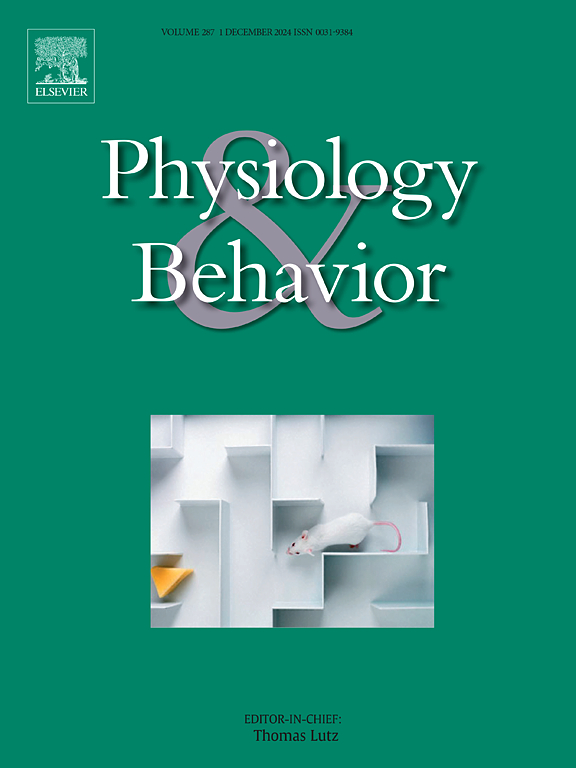The dopaminergic and opioidergic interactions in the nucleus accumbens in the suppression of pain affect: Exploring their impact on formalin-induced pain in rats
IF 2.4
3区 医学
Q2 BEHAVIORAL SCIENCES
引用次数: 0
Abstract
Recent studies suggest that the nucleus accumbens (NAc) may influence the brain's response to pain signals, indicating a role beyond motivation and reward. The study delved into how the D1-like dopamine receptors (D1Rs) and μ-opioid receptors (MOR) interact in the NAc region in the context of formalin-induced pain. Rats received intra-accumbal various doses of morphine as an MOR agonist (5, 10, 25, and 50 mmol/0.5μl) and different doses of SKF38393 as a selective D1Rs agonist (1.5, 3, 6, and 12 mmol/0.5μl) in separate experimental groups, respectively. In the second stage, animals received different doses of SCH23390 as a selective D1Rs antagonist (1.5, 3, 6, and 12 mmol) before an effective dose of SKF38393 (6 mmol) and morphine (10 mmol). The rats were then given naloxone as an MOR antagonist (1.5, 5, and 15 mmol) before being given an effective dose of SKF38393 (6 mmol). In the formalin test, 50 µl formalin (2.5 %) was subcutaneously injected into the rat's hind paw to induce pain behavioral responses. The main findings indicated that the opioidergic and dopaminergic systems in the NAc region interact to create analgesic effects. The injection of morphine and SKF38393 into the NAc resulted in pain-relieving impacts. However, SCH23390 decreased the antinociceptive impacts of SKF38393 and morphine. Similarly, naloxone reduced the analgesic effects of SKF38393. The interactions between D1Rs and MOR can lead to synergistic effects. Therefore, using D1Rs agonists along with morphine can enhance the antinociceptive effect of morphine while reducing its side effects.
伏隔核内多巴胺能和阿片能相互作用对疼痛抑制的影响:探讨其对福尔马林致痛大鼠的影响。
最近的研究表明,伏隔核(NAc)可能影响大脑对疼痛信号的反应,表明它的作用超出了动机和奖励。本研究探讨了d1样多巴胺受体(D1-like dopamine receptor, D1Rs)和μ-阿片受体(μ-opioid receptor, MOR)在福尔马林诱导疼痛时在NAc区域的相互作用。在不同的实验组大鼠分别给予不同剂量的吗啡作为MOR激动剂(5、10、25和50 mmol/0.5μl)和不同剂量的SKF38393作为选择性D1Rs激动剂(1.5、3、6和12 mmol/0.5μl)。在第二阶段,动物在SKF38393 (6 mmol)和吗啡(10 mmol)有效剂量之前,接受不同剂量的SCH23390作为选择性D1Rs拮抗剂(1.5、3、6和12 mmol)。然后在给予有效剂量的SKF38393 (6 mmol)之前,给予纳洛酮作为MOR拮抗剂(1.5、5和15 mmol)。在福尔马林实验中,大鼠后爪皮下注射50µl(2.5%)福尔马林,诱导疼痛行为反应。主要研究结果表明,NAc区域的阿片能和多巴胺能系统相互作用产生镇痛作用。在NAc内注射吗啡和SKF38393有镇痛作用。然而,SCH23390降低了SKF38393和吗啡的抗伤感受作用。同样,纳洛酮降低了SKF38393的镇痛作用。D1Rs与MOR之间的相互作用可产生协同效应。因此,与吗啡联合使用D1Rs激动剂可以增强吗啡的抗感觉作用,同时减少吗啡的副作用。
本文章由计算机程序翻译,如有差异,请以英文原文为准。
求助全文
约1分钟内获得全文
求助全文
来源期刊

Physiology & Behavior
医学-行为科学
CiteScore
5.70
自引率
3.40%
发文量
274
审稿时长
47 days
期刊介绍:
Physiology & Behavior is aimed at the causal physiological mechanisms of behavior and its modulation by environmental factors. The journal invites original reports in the broad area of behavioral and cognitive neuroscience, in which at least one variable is physiological and the primary emphasis and theoretical context are behavioral. The range of subjects includes behavioral neuroendocrinology, psychoneuroimmunology, learning and memory, ingestion, social behavior, and studies related to the mechanisms of psychopathology. Contemporary reviews and theoretical articles are welcomed and the Editors invite such proposals from interested authors.
 求助内容:
求助内容: 应助结果提醒方式:
应助结果提醒方式:


